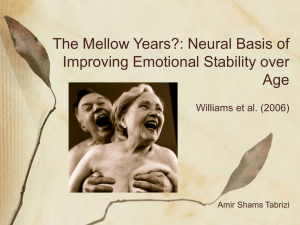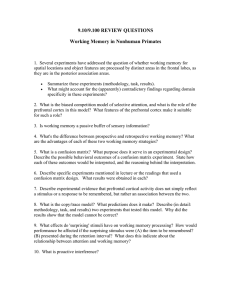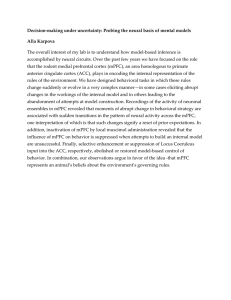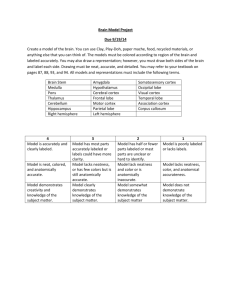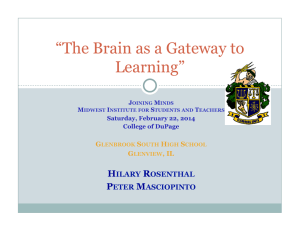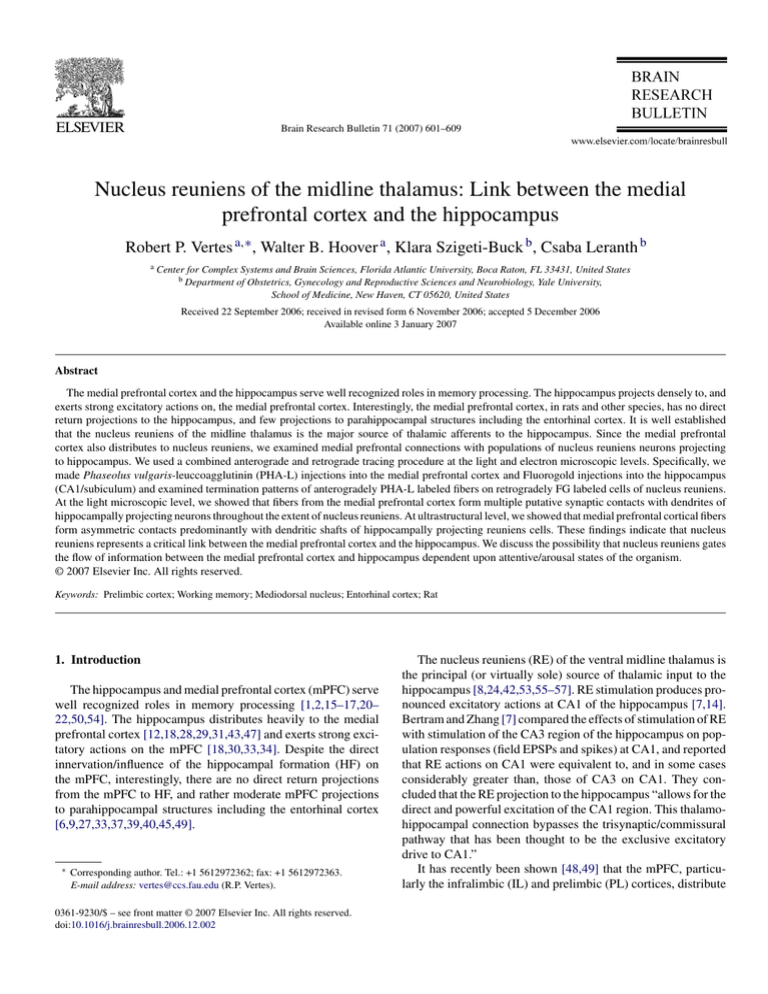
Brain Research Bulletin 71 (2007) 601–609
Nucleus reuniens of the midline thalamus: Link between the medial
prefrontal cortex and the hippocampus
Robert P. Vertes a,∗ , Walter B. Hoover a , Klara Szigeti-Buck b , Csaba Leranth b
a
Center for Complex Systems and Brain Sciences, Florida Atlantic University, Boca Raton, FL 33431, United States
b Department of Obstetrics, Gynecology and Reproductive Sciences and Neurobiology, Yale University,
School of Medicine, New Haven, CT 05620, United States
Received 22 September 2006; received in revised form 6 November 2006; accepted 5 December 2006
Available online 3 January 2007
Abstract
The medial prefrontal cortex and the hippocampus serve well recognized roles in memory processing. The hippocampus projects densely to, and
exerts strong excitatory actions on, the medial prefrontal cortex. Interestingly, the medial prefrontal cortex, in rats and other species, has no direct
return projections to the hippocampus, and few projections to parahippocampal structures including the entorhinal cortex. It is well established
that the nucleus reuniens of the midline thalamus is the major source of thalamic afferents to the hippocampus. Since the medial prefrontal
cortex also distributes to nucleus reuniens, we examined medial prefrontal connections with populations of nucleus reuniens neurons projecting
to hippocampus. We used a combined anterograde and retrograde tracing procedure at the light and electron microscopic levels. Specifically, we
made Phaseolus vulgaris-leuccoagglutinin (PHA-L) injections into the medial prefrontal cortex and Fluorogold injections into the hippocampus
(CA1/subiculum) and examined termination patterns of anterogradely PHA-L labeled fibers on retrogradely FG labeled cells of nucleus reuniens.
At the light microscopic level, we showed that fibers from the medial prefrontal cortex form multiple putative synaptic contacts with dendrites of
hippocampally projecting neurons throughout the extent of nucleus reuniens. At ultrastructural level, we showed that medial prefrontal cortical fibers
form asymmetric contacts predominantly with dendritic shafts of hippocampally projecting reuniens cells. These findings indicate that nucleus
reuniens represents a critical link between the medial prefrontal cortex and the hippocampus. We discuss the possibility that nucleus reuniens gates
the flow of information between the medial prefrontal cortex and hippocampus dependent upon attentive/arousal states of the organism.
© 2007 Elsevier Inc. All rights reserved.
Keywords: Prelimbic cortex; Working memory; Mediodorsal nucleus; Entorhinal cortex; Rat
1. Introduction
The hippocampus and medial prefrontal cortex (mPFC) serve
well recognized roles in memory processing [1,2,15–17,20–
22,50,54]. The hippocampus distributes heavily to the medial
prefrontal cortex [12,18,28,29,31,43,47] and exerts strong excitatory actions on the mPFC [18,30,33,34]. Despite the direct
innervation/influence of the hippocampal formation (HF) on
the mPFC, interestingly, there are no direct return projections
from the mPFC to HF, and rather moderate mPFC projections
to parahippocampal structures including the entorhinal cortex
[6,9,27,33,37,39,40,45,49].
∗
Corresponding author. Tel.: +1 5612972362; fax: +1 5612972363.
E-mail address: vertes@ccs.fau.edu (R.P. Vertes).
0361-9230/$ – see front matter © 2007 Elsevier Inc. All rights reserved.
doi:10.1016/j.brainresbull.2006.12.002
The nucleus reuniens (RE) of the ventral midline thalamus is
the principal (or virtually sole) source of thalamic input to the
hippocampus [8,24,42,53,55–57]. RE stimulation produces pronounced excitatory actions at CA1 of the hippocampus [7,14].
Bertram and Zhang [7] compared the effects of stimulation of RE
with stimulation of the CA3 region of the hippocampus on population responses (field EPSPs and spikes) at CA1, and reported
that RE actions on CA1 were equivalent to, and in some cases
considerably greater than, those of CA3 on CA1. They concluded that the RE projection to the hippocampus “allows for the
direct and powerful excitation of the CA1 region. This thalamohippocampal connection bypasses the trisynaptic/commissural
pathway that has been thought to be the exclusive excitatory
drive to CA1.”
It has recently been shown [48,49] that the mPFC, particularly the infralimbic (IL) and prelimbic (PL) cortices, distribute
602
R.P. Vertes et al. / Brain Research Bulletin 71 (2007) 601–609
prominently to RE. The combined demonstration, then, that
mPFC projects to RE and RE in turn to HF, suggests that RE
may represent an important relay between the mPFC and hippocampus. It remains to be determined whether mPFC fibers
distributing to RE contact RE neurons projecting to the hippocampus. To assess this, we made anterograde tracer injections
(PHA-L) in the ventral mPFC and retrograde injections (Fluorogold) in the CA1/subiculum of HF and examined, at the
light and ultrastructural level, synaptic connections of mPFC
fibers on RE neurons projecting to the hippocampus. We showed
that mPFC fibers form asymmetric (excitatory) contacts predominantly on dendritic shafts of RE cells projecting to HF.
RE thus appears to be a critical link between the mPFC and
HF, completing an important loop between these structures
(HF → mPFC → RE → HF).
2. Materials and methods
2.1. Animals and surgical protocols
Twelve male Sprague–Dawley rats (Charles River, Wilmington, MA) weighing 275–350 g were used. Experiments were approved by the Florida Atlantic
University Institutional Animal Care and Use Committee and conform to all
federal regulations and the National Institute of Health guidelines for the care
and use of laboratory animals.
Under sodium pentobarbital anesthesia (50 mg/kg, ip), each rat received
an injection of Phaseolus vulgaris-leucoagglutinin (PHA-L) in the medial prefrontal cortex and an injection of Fluorogold (FG) in the hippocampus. Powdered
lectin from P. vulgaris-leucoagglutinin (Vector Labs, Burlingame, CA) was
reconstituted to 5% in 0.05 M sodium phosphate buffer, pH 7.4. The PHA-L
solution was iontophoretically deposited in the brains of anesthetized rats by
means of a glass micropipette with an outside tip diameter of 40–60 m. The
stereotaxic coordinates were: AP, +2.6 to 2.8 mm to bregma, L, 0.5 mm and V,
4.5–5.2 mm. Positive direct current pulses (5–10 A) were applied through a
Grass stimulator (Model 88) coupled with a high voltage stimulator (Frederick
Haer Co., Brunswick, ME) at 2 s “on”/2 s “off” intervals for 40–50 min.
Fluorogold (Fluorochrome, LLC, Denver, CO) was dissolved in a 0.1 M
sodium acetate buffer (pH 5.0) to yield a 5% concentration. FG was either
iontophoretically deposited in the hippocampus or pressure injected using
a 1 l Hamilton syringe. FG was iontophoretically injected through a glass
micropipette with an outside tip diameter of 40–50 m for 5–10 min using the
same protocol described above for PHA-L. The pressure injections (0.03 l)
were made slowly over 10–15 min and the syringe was left in place for an
additional 10 min to prevent the tracer from spreading up the injection path.
The stereotaxic coordinates were: AP, −5.6 to −5.9 mm to bregma, L, 5.4 to
+5.8 mm, and V, 4.6–6.2 mm.
After a survival period of 7–10 days, rats were deeply anesthetized and
perfused transcardially with 50 ml of heparinized saline, followed by a fixative
containing 4% paraformaldehyde, 0.1% glutaraldehyde, and 15% picric acid
in 0.1 M phosphate buffer (PB) (pH 7.4). The brains were removed and postfixed overnight in 4% paraformaldehyde and 15% picric acid in 0.1 M PB. The
brains were then washed with 0.1 M PB subsequently sectioned (50 m) with a
vibratome and collected in 0.1 M PB for light and electron microscopic analysis.
2.2. Light microscopic procedures
Two procedures were used for the dual visualization of PHA-L labeled
fibers and FG retrogradely labeled neurons. The first procedure involved an
intensification of FG retrogradely labeled neurons and the second procedure an
intensification of PHA-L anterogradely labeled fibers. All sections were initially
treated with 1% sodium borohydride in 0.1 M PB for 30 min to remove excessive
aldehydes. They were then washed three times for 5 min each (3 × 5 min) in PB
and incubated for 60 min in 0.5% bovine serum albumin in 0.1 M Tris-buffered
saline (TBS, pH 7.6) at room temperature (RT) to minimize nonspecific labeling.
Following this, sections were incubated for 20 h at RT in diluent [0.1% bovine
serum albumin (BSA) in TBS containing 0.25% Triton X-100] and biotinylated
goat anti-PHA-L (Vector Labs, Burlingame, CA) at a dilution of 1:500.
For the first procedure sections were washed (0.1 M PB) and placed for 1 h in
1:400 concentration of biotinylated rabbit anti-goat immunoglobulin (IgG) and
diluent. Following another PB wash, sections were incubated for 1 h in 1:100
concentration of peroxidase–avidin complex (ABC) from the Vector Elite kit and
diluent. The peroxidase reaction product was visualized by incubation in a solution containing 0.022% 3,3 -diaminobenzidine (DAB) and 0.003% H2 O2 in TBS
for 6 min. Sections were then re-incubated in 0.5% BSA in 0.1 M TBS for 15 min,
and incubated for 48 h at RT in 1:200 concentration of rabbit anti-FG (Fluorochrome, LLC, Denver, CO) and diluent. Sections were then washed (0.1 M PB)
and placed for 2 h in a 1:100 concentration of a secondary antiserum, donkey antirabbit immunoglobulin (Jackson ImmunoResearch Laboratories, West Grove,
PA) and diluent. Following another PB wash, sections were incubated for 2 h in a
1:200 concentration of rabbit peroxidase-anti-peroxidase (Jackson ImmunoResearch Laboratories, West Grove, PA) and diluent. Following 0.1 M PB washes,
sections were re-incubated in the same concentrations in donkey anti-rabbit
immunoglobulin and rabbit peroxidase-anti-peroxidase for 2 h each—double
bridge procedure. After final washes (0.1 M PB), the reaction product was visualized by an incubation in a solution containing 0.015% 3,3 -diaminobenzidine,
0.015% cobalt acetate and 0.003% H2 O2 in TBS for 6 min.
For the second procedure, sections were washed (0.1 M PB) and placed
for 1 h in 1:400 concentration of biotinylated horse anti-goat immunoglobulin
(IgG) and diluent. Following another PB wash, sections were incubated for 1 h
in 1:100 concentration of peroxidase–avidin complex (ABC) from the Vector
Elite kit and diluent. After a final PB wash, the peroxidase reaction product was
visualized by incubation in a solution containing 0.015% cobalt acetate, 0.022%
3,3 -diaminobenzidine (DAB) and 0.003% H2 O2 in TBS for 5 min. Sections
were then re-incubated in 0.5% BSA in 0.1 M TBS for 15 min, and then incubated
for 48 h at RT in 1:200 concentration of rabbit anti-FG (Fluorochrome, LLC,
Denver, CO) and diluent. Sections were then washed (0.1 M PB) and placed for
2 h in a 1:400 concentration of a secondary antiserum, biotinylated donkey antirabbit immunoglobulin (Jackson ImmunoResearch Laboratories, West Grove,
PA) and diluent. Following another PB wash, sections were incubated for 1 h
in 1:100 concentration of peroxidase–avidin complex (ABC) from the Vector
Elite kit and diluent. Following a final PB wash, the peroxidase reaction product
reaction was visualized by an incubation in a solution containing 0.015% 3,3 diaminobenzidine and 0.003% H2 O2 in TBS for 5 min. All sections were rerinsed in PBS (3 × 1 min) and mounted onto chrome-alum gelatin-coated slides.
An adjacent series of sections from each rat was stained with cresyl violet for
anatomical reference. Sections were examined using light and darkfield optics.
The first procedure gave rise to brown appearing PHA-L labeled fibers on
black FG labeled cells and the second procedure to black PHA-L labeled fibers
on brown FG-labeled cells. The lightfield photomicrographs of injection sites,
labeled fibers and cells were taken with a Nikon DXM1200 camera mounted on
a Nikon Eclipse E600 microscope. The captured images were then assembled
into photomontages using Image-Pro Plus software (Media Cybernetics, Inc.,
Silver Spring, MD). Single photomicrographs (non-montages) were taken with
ACT-1 software (Nikon, USA). Digital images were enhanced (brightness and
contrast) using Adobe PhotoShop 9.0 (Mountain View, CA).
2.3. Electron microscopic procedures
To allow for antibody penetration, the sections were incubated in a cryoprotective solution (20% sucrose in 0.1 M PB) until sections sank and freeze-thawed
in liquid nitrogen. The tissue was then blocked with a diluent solution (1% BSA,
0.1% glycine, 0.1% l-lysine, and 4% normal goat serum in 0.1 M PB) for 30 min
to reduce non-specific labeling and then incubated for 48 h in a cocktail of primary antibodies against both the PHA-L and FG as described above for light
microscopic procedures. Following copious washes in PB, sections were incubated in ABC at a concentration of 1:50 in 0.1 M PB for 2 h. Following further
washes, sections were immersed for 4 min in a nickel-intensified DAB/glucose
oxidase solution (15 mg DAB, 12 mg ammonium chloride, 0.12 mg glucose
oxidase, 600 l of 0.05 M nickel ammonium sulphate, and 600 l of 10% Bd-glucose in 40 ml 0.1 M PB) to visualize the PHA-L reaction product. FG was
visualized using silver intensification of a gold secondary antibody. Following a DAB reaction, the tissue was washed and blocked again in preparation
R.P. Vertes et al. / Brain Research Bulletin 71 (2007) 601–609
for incubation in 1.2 nm gold conjugated anti-rabbit (Nanoprobes, Yaphank,
NY) for 30 min in diluent (same as above with 1% cold water fish gelatin and
0.05% Tween-20 added). The tissue was incubated for 2 h in the secondary
antibody and washed with PB. The sections were then treated with 1% glutaraldehyde in 0.1 M PB for 10 min to fix the gold particles. Following initial
washes of PB and secondary washes of double-distilled water (DDW), sections were placed for 2 min in a HQ Silver Kit (Nanoprobes, Yaphank, NY) to
intensify the gold reaction. The tissue was washed with DDW followed by PB.
Sections were then osmicated (1% osmium tetroxide in 0.1 M PB) for 10 min,
followed by copious washes of initially PB and then DDW. The tissue was then
dehydrated in ethanol, 50–70%. Sections were immersed in 70% ethanol with
1% uranyl acetate for 1 h, washed with 70% ethanol, and further dehydrated
using 95% and100% ethanol followed by propylene oxide. The tissue was then
exposed to a 1:1 mixture of propylene oxide and a Durcupan mixture (ACM
Fluka, Bucks, Switzerland) overnight. Sections were immersed in the Durcupan
mixture for 4 h and mounted between liquid release agent-coated slides and coverslips and baked at 60 ◦ C for 48 h to allow for polymerization. Selected areas
were photo-documented for putative synapses and trimmed for sectioning. Ultrathin sections (80–85 nm) were collected serially on single-slot Formvar-coated
grids and contrasted with lead citrate. The ultrastructure was examined with
a Tecnai 12 transmission electron microscope equipped with an AMT Advan-
603
tage 4.00 HR/HR-B CCD camera system (Advanced Microscopy Techniques,
Danvers, MA).
3. Results
Using a combined anterograde–retrograde tracing procedure,
we describe the distribution of PHA-L labeled fibers from the
mPFC onto populations of cells of nucleus reuniens that project
to the hippocampus. In accord with previous work [48,49], an
injection of PHA-L into the ventral mPFC (Fig. 2a), essentially confined to the infralimbic and prelimbic cortices, gave
rise to pronounced labeling of RE. Labeled fibers were not,
however, restricted to RE but were also present in other nuclei
of the midline thalamus including the paraventricular, paratenial, mediodorsal, intermediodorsal, interanteromedial, central
medial and rhomboid nuclei of the thalamus. Fig. 1a depicts
extra-RE labeling antero-dorsally in the thalamus within the
Fig. 1. (a–d) Series of low magnification rostrocaudally aligned photomicrographs through the thalamus showing: (1) the distribution of PHA-L labeled fibers
(brown) in the paratenial (PT), paraventricular (PV) and reuniens (RE) nuclei of the midline thalamus produced by a PHA-L injection in the medial prefrontal cortex
(mPFC, see Fig. 2a), and (2) retrogradely labeled cells (black) in RE produced by a Fluorogold injection in the hippocampus (Fig. 2b). Note the significant overlap
of PHA-L labeled fibers and retrogradely labeled cells at three rostrocaudal levels of RE, but no overlap in PT and PV due to the absence of retrogradely labeled cells
in PT/PV. Scale bar, 300 m. FX, fornix, MT, mammillothalamic tract, PT, paratenial nucleus of thalamus; PV, paraventricular nucleus of thalamus; RE, nucleus
reuniens of thalamus, V3, third ventricle. (For interpretation of the references to colour in this figure legend, the reader is referred to the web version of the article.)
604
R.P. Vertes et al. / Brain Research Bulletin 71 (2007) 601–609
Fig. 2. (a) Low magnification photomicrograph of a PHA-L injection in the medial prefrontal cortex, virtually confined to the prelimbic cortex. (b) Low magnification
photomicrograph of a FG injection in the ventral hippocampus, with the core of the injection (arrow) centered in stratum lacunosum-moleculare of ventral CA1.
(c) Low magnification photomicrograph showing pronounced overlap in RE (dorsolateral to the third ventricle) of PHA-L labeled fibers (black) and FG labeled
cells (brown). (d) High magnification photomicrograph showing putative synaptic contacts of a PHA-L labeled fiber (arrow) on a dendrite of a FG labeled cell. (e
and f) High magnification photomicrographs showing putative synaptic contacts (arrows) of PHA-L labeled fibers on proximal dendrites FG labeled cells (f, higher
magnification of d). Scale bars, a and b, 1200 m; for c, 60 m; for d, 25 m; for e and f, 15 m. AC, anterior cingulate cortex; ACC, nucleus accumbens; AGl,
lateral agranular (frontal) cortex; CA1, CA1 field of Ammon’s horn of hippocampal formation; EC, entorhinal cortex; IL, infralimbic cortex; OC, occipital cortex;
PL, prelimbic cortex; SUBv, ventral subiculum of hippocampal formation. (For interpretation of the references to colour in this figure legend, the reader is referred
to the web version of the article.)
R.P. Vertes et al. / Brain Research Bulletin 71 (2007) 601–609
605
Fig. 3. (a–d) Series of consecutive electron micrographs within nucleus reuniens showing asymmetric contacts of a single PHA-L labeled (F) fiber (from the mPFC)
on a labeled dendritic shaft, identified by the presence of numerous silver intensified gold deposits (arrows in D), of a RE cell retrogradely from the hippocampus.
Note also the presence of asymmetric contacts of an unlabeled fiber (A) on the same labeled dendrite (D). Scale bar, 1 m.
606
R.P. Vertes et al. / Brain Research Bulletin 71 (2007) 601–609
paratenial nucleus and less so in the medially adjacent paraventricular nucleus.
Although RE was a main, but not the sole, target of labeled
fibers from mPFC, labeled cells were virtually restricted to RE
following retrograde FG injections in HF. As depicted for three
levels of RE (Fig. 1b–d), labeled neurons were present rostrocaudally throughout RE following a HF injection (Fig. 2b),
most densely concentrated ipsilaterally (left side) within rostral, ventral and lateral subdivisions of RE [38,44]. Very few
labeled neurons were observed within the thalamus outside of
RE. Accordingly, RE was the only nucleus of the thalamus
showing a convergence of anterogradely labeled fibers (from
mPFC) and retrogradely labeled neurons (from HF). As further
shown in Fig. 1, there was a significant overlap of PHA-L labeled
fibers (brown) and FG labeled cells (black), at rostral (Fig. 1b),
intermediate (Fig. 1c) and caudal (Fig. 1d) levels of RE, most
pronounced rostrally—the site of the heaviest concentration of
retrogradely labeled neurons in RE.
Fig. 2c shows a dense plexus of labeled fibers interspersed
among, and in close proximity to, labeled cells in RE. As
depicted at higher levels of magnification (Fig. 2d–f) labeled
terminals overlay and form putative synaptic contacts with proximal dendrites (arrows in Fig. 2d–f) of retrogradely labeled RE
neurons.
At the ultrastructural level, PHA-L labeled terminals formed
asymmetric connections with both FG-labeled (Fig. 3a–d) and
unlabeled (Fig. 4a) dendrites of RE neurons. The consecutive
series of ultrathin sections of Fig. 3 show PHA-L labeled terminals (F) making asymmetric contacts with a labeled proximal
dendrite (D) of a retrogradely labeled RE neuron—identified by
the presence of several silver intensified gold particles (arrows).
As further shown (Fig. 3), an unlabeled terminal (A) asymmetrically connects with this same dendritic element. Although
unknown, it is possible that the unlabeled axon also originates
from the mPFC; that is, PHA-L injections in mPFC would likely
only labeled a small subset of prefrontal cells projecting to RE.
In a similar manner, as shown in Fig. 4, PHA-L labeled (F)
and unlabeled (A) terminals were found to form (predominantly)
asymmetric connections with unlabeled dendrites (D) of RE
cells (arrows in Fig. 4a). These contacts (labeled or unlabeled
Fig. 4. (a) An electron micrograph showing a PHA-L labeled fiber (F, arrow head) from the mPFC forming an asymmetric contact with an unlabeled dendrite within
RE and several (four) unlabeled asymmetric contacts (A, arrow heads) with the same dendritic process. (b) A PHA-L labeled fiber (F) from the mPFC in close
proximity but without synaptic contact on a labeled RE cell body (C) and nucleus (N). (c) An unlabeled symmetric contact (A, arrow head) with a labeled RE cell
body (C). Scale bar, 1 m.
R.P. Vertes et al. / Brain Research Bulletin 71 (2007) 601–609
fibers with unlabeled dendrites) does not negate the possibility
that the unlabeled dendrites belong to cells that also project to
the hippocampus. Specifically, FG injections in HF (or those
restricted to the ventral CA1/subiculum) would undoubtedly
only retrogradely fill a small percentage of RE cells projecting
to HF. Fig. 4b shows a labeled terminal (F) in close proximity, but without synaptic contact, on a labeled cell body (C) in
RE. No labeled terminals were found to make synaptic connections with cell bodies. Fig. 4c depicts a unlabeled (A) symmetric
contact on a labeled cell body (C), indicating local or extraRE inhibitory connections with hippocampally projecting RE
neurons.
4. Discussion
At the light microscopic level, we demonstrated a pronounced
overlap in nucleus reuniens of PHA-L labeled fibers from the
medial prefrontal cortex and retrogradely labeled cells from the
hippocampus, as well as multiple putative contacts of labeled
terminals onto dendrites of RE cells projecting to the hippocampus. At the ultrastructural level, we showed that mPFC
fibers form asymmetric contacts predominantly with dendritic
shafts of hippocampally projecting RE cells. These findings
suggest that mPFC exerts excitatory actions on populations of
RE cells that project to the hippocampus, and as such RE may
serve as an important relay between the ventral mPFC and the
hippocampus.
Although the inputs and outputs of RE have been described
in separate studies (see Ref. [51]) the present report is the first
to examine RE afferents/efferents in a single study, and by so
doing demonstrated a strong convergence within RE of fibers
from the mPFC onto RE hippocampally projecting cells (see
Fig. 1).
Medial prefrontal fibers were shown to form asymmetric connections with proximal dendrites of RE neurons projecting to
HF. Unlabeled fibers also made asymmetric connections with
labeled dendrites, and in some instances the same (labeled) dendrites were contacted by labeled and unlabeled mPFC fibers
(Fig. 3). Since even large PHA-L injections in mPFC would
undoubtedly only label a small percentage of mPFC cells, it is
very possible that many of the unlabeled profiles on labeled dendrites also represent fibers originating from mPFC. In a similar
manner, labeled fibers forming connections with unlabeled dendrites could represent contacts on hippocampally projecting RE
neurons since retrograde injections were restricted to a small
region of the terminal RE field in HF [8,13,38,53,57].
RE fibers innervating the hippocampus appear to mainly
utilize glutamate. Specifically, RE is densely populated by
glutamatergic cells [26] and RE neurons were shown to be retrogradely labeled following [3 H]d-aspartate injections in HF [8].
Halasy et al. [23] recently described a tight band of VGLUT2
terminals in stratum lacunosum-moleculare of CA1 that were
thought to originate from RE. Taken together, this suggests
that mPFC can indirectly exert excitatory actions on the hippocampus, mediated through an excitatory, glutamatergic, relay
within RE. Finally, RE selectively targets CA1 and the subiculum but avoids CA3 and the dentate gyrus ([8,13,38,53,57],
607
present results), and the CA1/subiculum is the source of origin of efferents to the mPFC [12,18,28,29,31,43,47]. This
indicates that projections between structures are directly
routed through CA1 (and subiculum): CA1 → mPFC →
RE → CA1.
4.1. Functional considerations
As discussed, in the absence of direct projections from the
mPFC to the hippocampus, the nucleus reuniens appears to
represent an important link from the mPFC to HF involved in
memory processing. The mnemonic function commonly associated with the prefrontal cortex, and one extensively examined,
is working memory—or the temporary storage and utilization
of information over short intervals [1,2,20,22].
As well documented for monkeys [22], the mPFC of rats, or
specifically the prelimbic cortex of mPFC [51], has been shown
to participate in tasks requiring the maintenance of information
over time—or working memory. The reversible or irreversible
inactivation of the ventral PFC (or PL) produces marked deficits
in delayed response tasks involving short or long delays [19,51].
Further, cells of the ventral mPFC in rats show sustained activity
during the delay period of delay tasks [3,4,36].
Whereas information is retained for the short term in the PFC,
it is widely acknowledged the long term storage of information
requires the hippocampus and associated structures of the medial
temporal lobe [15–17,41,58]. Regarding the dual (and interactive) roles of the PFC and HF in memory processing, Buckner
et al. [10,11] recently put forth the intriguing hypothesis that the
prefrontal cortex uses information in the short term (working
memory) to deal with impending task demands and its long term
storage may be simply a by product of its use in meeting immediate behavioral requirements. The conversion of short (working
memory) to long term stores might then involve a transfer of
information from mPFC to the hippocampus/parahippocampus.
In the absence of direct mPFC inputs to the HF, indirect projections from PFC to HF via RE may represent an important route
for the transfer of information from PFC to the medial temporal
lobe involved in memory processing.
Although speculative, it is possible that information relayed
through RE (in contrast to direct cortical-hippocampal projections) may be subject to modulating influences acting on
RE that affect that transfer. For instance, Van der Werf et al.
[46] have proposed that the midline thalamus, including RE,
regulates processes such as arousal, attention and awareness.
In support of this, the midline thalamus receive pronounced
input from ‘arousal related’ sites of the brainstem [32,35,52]
as well as from ‘wake-promoting’ orexin neurons of the lateral
hypothalamus [5,25]. It is possible that by modulating levels
of arousal/attention, RE serves to gate the flow of information
between the mPFC and HF thereby controlling the type of prefrontal information that gains access to the hippocampus for its
long term storage.
Conflict of interest
No conflict of interest.
608
R.P. Vertes et al. / Brain Research Bulletin 71 (2007) 601–609
Acknowledgments
This research was supported by NIMH grants MH35883 and
MH63519 to RPV, and NIH and NIMH grants NS 042644 and
MH 060858 to CL.
[22]
[23]
[24]
References
[1] A. Baddeley, Working Memory, Clarendon Press, Oxford, 1986.
[2] A. Baddeley, Recent developments in working memory, Curr. Opin. Neurobiol. 8 (1998) 234–238.
[3] E.H. Baeg, Y.B. Kim, K. Huh, I. Mook-Jung, H.T. Kim, M.W. Jung, Dynamics of population code for working memory in the prefrontal cortex, Neuron
40 (2003) 177–188.
[4] A.S. Batuev, N.P. Kursina, A.P. Shutov, Unit activity of the medial wall of
the frontal cortex during delayed performance in rats, Behav. Brain Res.
41 (1990) 95–102.
[5] L. Bayer, E. Eggermann, B. Saint-Mleux, D. Machard, B.E. Jones, M.
Muhlethaler, M. Serafin, Selective action of orexin (hypocretin) on nonspecific thalamocortical projection neurons, J. Neurosci. 22 (2002) 7835–
7839.
[6] R.M. Beckstead, Autoradiographic examination of corticocortical and subcortical projections of the mediodorsal-projection (prefrontal) cortex in the
rat, J. Comp. Neurol. 184 (1979) 43–62.
[7] E.H. Bertram, D.X. Zhang, Thalamic excitation of hippocampal CA1 neurons: a comparison with the effects of CA3 stimulation, Neuroscience 92
(1999) 15–26.
[8] H. Bokor, A. Csaki, K. Kocsis, J. Kiss, Cellular architecture of the nucleus
reuniens thalami and its putative aspartatergic/glutamatergic projection to
the hippocampus and medial septum in the rat, Eur. J. Neurosci. 16 (2002)
1227–1239.
[9] S.L. Buchanan, R.H. Thompson, B.L. Maxwell, D.A. Powell, Efferent connections of the medial prefrontal cortex in the rabbit, Exp. Brain Res. 100
(1994) 469–483.
[10] R.L. Buckner, W.M. Kelley, S.E. Petersen, Frontal cortex contributes to
human memory formation, Nat. Neurosci. 2 (1999) 311–314.
[11] R.L. Buckner, J. Logan, D.I. Donaldson, M.E. Wheeler, Cognitive neuroscience of episodic memory encoding, Acta. Psychol. 105 (2000) 127–139.
[12] D.B. Carr, S.R. Sesack, Hippocampal afferents to the rat prefrontal cortex:
synaptic targets and relation to dopamine terminals, J. Comp. Neurol. 369
(1996) 1–15.
[13] M.J. Dolleman-Van der Weel, M.P. Witter, Projections from the nucleus
reuniens thalami to the entorhinal cortex, hippocampal field CA1, and the
subiculum in the rat arise from different populations of neurons, J. Comp.
Neurol. 364 (1996) 637–650.
[14] M.J. Dolleman-Van der Weel, F.H. Lopes da Silva, M.P. Witter, Nucleus
reuniens thalami modulates activity in hippocampal field CA1 through
excitatory and inhibitory mechanisms, J. Neurosci. 17 (1997) 5640–5650.
[15] Y. Dudai, The Neurobiology of Memory. Concepts, Findings, Trends,
Oxford University Press, Oxford, 1989.
[16] H. Eichenbaum, N.J. Cohen, From Conditioning to Conscious Recollection: Memory Systems of the Brain, Oxford University Press, New York,
2001.
[17] H. Eichenbaum, G. Schoenbaum, B. Young, M. Bunsey, Functional organization of the hippocampal memory system, Proc. Natl. Acad. Sci. 93
(1996) 13500–13507.
[18] F. Ferino, A.M. Thierry, J. Glowinski, Anatomical and electrophysiological
evidence for a direct projection from Ammon’s horn to the medial prefrontal
cortex in the rat, Exp. Brain Res. 65 (1987) 421–426.
[19] S.B. Floresco, J.K. Seamans, A.G. Phillips, Selective roles for hippocampal, prefrontal cortical, and ventral stiatal circuits in radial arm maze tasks
with or without delay, J. Neurosci. 17 (1997) 1880–1890.
[20] J.M. Fuster, The prefrontal cortex—an update: time is of the essence,
Neuron 30 (2001) 319–333.
[21] P.S. Goldman-Rakic, The issue of memory in the study of prefrontal function, in: A.M. Thierry, P.S. Goldman-Rakic, Y. Christen (Eds.), Motor
[25]
[26]
[27]
[28]
[29]
[30]
[31]
[32]
[33]
[34]
[35]
[36]
[37]
[38]
[39]
[40]
[41]
[42]
[43]
[44]
and Cognitive Functions of the Prefrontal Cortex, Springer-Verlag, Berlin,
1994, pp. 112–123.
P.S. Goldman-Rakic, Cellular basis of working memory, Neuron 14 (1995)
477–485.
K. Halasy, T. Hajszan, E.G. Kovacs, T.T. Lam, C. Leranth, Distribution and
origin of vesicular glutamate transporter 2-immunoreactive fibers in the rat
hippocampus, Hippocampus 14 (2004) 908–918.
M. Herkenham, Connections of nucleus reuniens thalami: evidence for
a direct thalamo-hippocampal pathway in the rat, J. Comp. Neurol. 177
(1978) 589–610.
H. Huang, P. Ghosh, A.N. van den Pol, Prefrontal cortex-projecting
glutamatergic thalamic paraventricular nucleus-excited by hypocretin: a
feedforward circuit that may enhance cognitive arousal, J. Neurophysiol.
95 (2006) 1656–1668.
E.E. Hur, L. Zaborszky, Vglut2 afferents to the medial prefrontal and
primary somatosensory cortices: a combined retrograde tracing in situ
hybridization study, J. Comp. Neurol. 483 (2005) 351–373.
K.M. Hurley, H. Herbert, M.M. Moga, C.B. Saper, Efferent projections
of the infralimbic cortex of the rat, J. Comp. Neurol. 308 (1991) 249–
276.
A. Ishikawa, S. Nakamura, Convergence and interaction of hippocampal and amygdalar projections within the prefrontal cortex in the rat, J.
Neurosci. 23 (2003) 9987–9995.
T.M. Jay, M.P. Witter, Distribution of hippocampal CA1 and subicular
efferents in the prefrontal cortex of the rat studied by means of anterograde transport of Phaseolus vulgaris-leucoagglutinin, J. Comp. Neurol.
313 (1991) 574–586.
T.M. Jay, F. Burette, S. Laroche, NMDA receptor dependent long term
potentiation in the hippocampal afferent fibre system to the prefrontal cortex
in the rat, Eur. J. Neurosci. 7 (1995) 247–250.
T.M. Jay, J. Glowinski, A.M. Thierry, Selectivity of the hippocampal projection to the prelimbic area of the prefrontal cortex in the rat, Brain Res.
505 (1989) 337–340.
K.E. Krout, R.E. Belzer, A.D. Loewy, Brainstem projections to midline
and intralaminar thalamic nuclei of the rat, J. Comp. Neurol. 448 (2002)
53–101.
S. Laroche, S. Davis, T.M. Jay, Plasticity at hippocampal to prefrontal
cortex synapses: dual roles in working memory and consolidation, Hippocampus 10 (2000) 438–446.
S. Laroche, T.M. Jay, A.M. Thierry, Long-term potentiation in the prefrontal
cortex following stimulation of the hippocampal CA1/subicular region,
Neurosci. Lett. 114 (1990) 184–190.
J.T. McKenna, R.P. Vertes, Afferent projections to nucleus reuniens of the
thalamus, J. Comp. Neurol. 480 (2004) 115–142.
A.A. Orlov, N.P. Kurzina, A.P. Shutov, Activity of medial wall neurons
in frontal cortex of rat brain during delayed response reactions, Neurosci.
Behav. Physiol. 18 (1988) 31–37.
R.L. Reep, J.V. Corwin, A. Hashimoto, R.T. Watson, Efferent connections
of the rostral portion of medial agranular cortex in rats, Brain Res. Bull. 19
(1987) 203–221.
P.Y. Risold, R.H. Thompson, L.W. Swanson, The structural organization
of connections between hypothalamus and cerebral cortex, Brain Res. Rev.
24 (1997) 197–254.
P. Room, F.T. Russchen, H.J. Groenewegen, A.H.M. Lohman, Efferent
connections of the prelimbic (area 32) and the infralimbic (area 25) cortices:
an anterograde tracing study in the cat, J. Comp. Neurol. 242 (1985) 40–55.
S.R. Sesack, A.Y. Deutch, R.H. Roth, B.S. Bunney, Topographical organization of the efferent projections of the medial prefrontal cortex in the rat:
an anterograde tract-tracing study with Phaseolus vulgaris leucoagglutinin,
J. Comp. Neurol. 290 (1989) 213–242.
L.R. Squire, Memory and Brain, Oxford University Press, New York, 1987.
H.S. Su, M. Bentivoglio, Thalamic midline cell populations projecting to
the nucleus accumbens, amygdala, and hippocampus in the rat, J. Comp.
Neurol. 297 (1990) 582–593.
L.W. Swanson, A direct projection from Ammon’s horn to prefrontal cortex
in the rat, Brain Res. 217 (1981) 150–154.
L.W. Swanson, Brain Maps: Structure of the Rat Brain, Elsevier, New York,
1998.
R.P. Vertes et al. / Brain Research Bulletin 71 (2007) 601–609
[45] M. Takagishi, T. Chiba, Efferent projections of the infralimbic (area 25)
region of the medial prefrontal cortex in the rat: an anterograde tracer
PHA-L study, Brain Res. 566 (1991) 26–39.
[46] Y.D. Van der Werf, M.P. Witter, H.J. Groenewegen, The intralaminar and
midline nuclei of the thalamus. Anatomical and functional evidence for
participation in processes of arousal and awareness, Brain Res. Rev. 39
(2002) 107–140.
[47] T. van Groen, J.M. Wyss, The connections of presubiculum and parasubiculum in the rat, Brain Res. 518 (1990) 227–243.
[48] R.P. Vertes, Analysis of projections from the medial prefrontal cortex to the
thalamus in the rat, with emphasis on nucleus reuniens, J. Comp. Neurol.
442 (2002) 163–187.
[49] R.P. Vertes, Differential projections of the infralimbic and prelimbic cortex
in the rat, Synapse 51 (2004) 32–58.
[50] R.P. Vertes, Hippocampal theta rhythm: a tag for short term memory, Hippocampus 15 (2005) 923–935.
[51] R.P. Vertes, Interactions among the medial prefrontal cortex, hippocampus
and midline thalamus in emotional and cognitive processing in the rat,
Neuroscience 142 (2006) 1–20.
[52] R.P. Vertes, G.F. Martin, Autoradiographic analysis of ascending projections from the pontine and mesencephalic reticular formation and the
[53]
[54]
[55]
[56]
[57]
[58]
609
median raphe nucleus in the rat, J. Comp. Neurol. 275 (1988) 511–
541.
R.P. Vertes, W.B. Hoover, A.C. do Valle, A. Sherman, J.J. Rodriguez, Efferent projections of reuniens and rhomboid nuclei of the thalamus in the rat,
J. Comp. Neurol. 499 (2006) 768–796.
R.P. Vertes, W.B. Hoover, G. Viana Di Prisco, Theta rhythm of the hippocampus: subcortical control and functional significance, Behav. Cogn.
Neurosci. Rev. 3 (2004) 173–2000.
M.P. Witter, H.J. Groenewegen, F.H. Lopes da Silva, A.H. Lohman,
Functional organization of the extrinsic and intrinsic circuitry of the
parahippocampal region, Prog. Neurobiol. 33 (1989) 161–253.
F.G. Wouterlood, Innervation of entorhinal principal cells by neurons of
the nucleus reuniens thalami. Anterograde PHA-L tracing combined with
retrograde fluorescent tracing and intracellular injection with lucifer yellow
in the rat, Eur. J. Neurosci. 3 (1991) 641–647.
F.G. Wouterlood, E. Saldana, M.P. Witter, Projection from the nucleus
reuniens thalami to the hippocampal region: light and electron microscopic
tracing study in the rat with the anterograde tracer Phaseolus vulgarisleucoagglutinin, J. Comp. Neurol. 296 (1990) 179–203.
S. Zola-Morgan, L.R. Squire, Neuroanatomy of memory, Annu. Rev. Neurosci. 16 (1993) 547–563.



